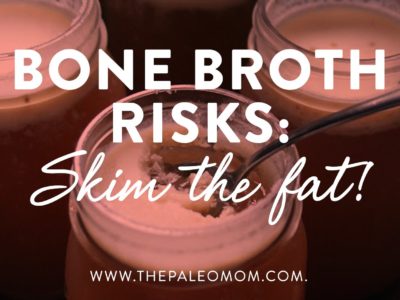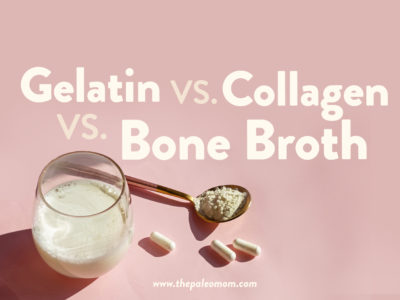The Paleo framework should settle around roughly balanced macronutrients; 30 to 40 percent fat is a healthy and comfortable zone for many people. See What About Fat?, Carbs Vs. Protein Vs. Fat: Insight from Hunter-Gatherers, The Diet We’re Meant to Eat, Part 3: How Much Meat versus Veggies? and Saturated Fat: Healthful, Harmful, or Somewhere In Between?. But apart from meat, seafood, and certain plants, like coconuts and avocados, where should this fat come from—especially when it comes to cooking and flavoring food?
Which Fats Should I Eat?
In a nutshell, excellent choices include cold-pressed olive oil, coconut oil, avocado oil, and palm oil, butter (preferably grass-fed), and rendered (clarified) ghee, lard, tallow, and duck fat (preferably pastured). Although whole-food fats (those naturally occurring in meat, eggs, seafood, nuts, seeds, avocados, coconuts, olives, and dairy, if tolerated) are generally superior to isolated fats and oils in terms of micronutrient density, these cooking fats also have an important place in the Paleo diet. Monounsaturated fats, saturated fats in reasonable quantities, and omega-3 fats are all excellent for supporting numerous functions in our bodies and assisting with the absorption of the fat-soluble vitamins A, D, E, and K, so oils composed primarily of one or more of these fats are ideal—the less refined, the better for additional nutrient retention.
Adequate fat intake is necessary for health, with saturated fats, monounsaturated fats, and polyunsaturated fats playing various roles. The main takeaways when it comes to fat intake are:
- Moderate saturated fat intake is healthy.
- Monounsaturated fats have lots of health benefits.
- It’s important to balance omega-3 with omega-6 fatty acid intake, which means anywhere from a 1:1 to a 1:4 ratio.
- An unrefined, minimally processed fat or oil contains more vitamins and other nutrients.
- Contrary to 40 years of anti–saturated fat propaganda, saturated fat is actually healthy, provided that intake is moderate (see )
Rendered animal fats are rich in vitamins (especially fat-soluble vitamins) and are delicious for cooking. It’s best to use fats from grass-fed and pasture-raised animals in order to avoid adding excess omega-6 fat to your diet. Animal fats are generally equally rich in saturated fat and monounsaturated fat and, when they come from grass-fed and pastured sources, typically have a good ratio of omega-3 to omega-6 fats.
Some plant oils are also great for cooking. Unlike the seed or grain oils that are generally called vegetable oils, like soybean, corn, and canola oils (in which the oil is extracted using solvents or a mechanical process called extrusion, which involves high heat and pressure), these healthy plant oils can easily be isolated from fatty plants using a process called cold pressing.
Coconut and palm oils are rich in medium-chain triglycerides (MCTs), which are a special type of “short”-chain saturated fat (unlike the longer saturated fatty acid chains typically found in animal fats). MCTs do not require bile salts for digestion. They diffuse passively from the intestines into the blood and do not have to be modified before they can be used as energy for our cells, and they are metabolized extremely easily, even by people without a gallbladder. Their chemical structure includes chains that are much shorter than those in most animal fats, and after being absorbed, they can be rapidly converted into ketone bodies by the liver (ketone bodies are water-soluble molecules normally produced as intermediates or by-products when the body accesses fat stores). Ketone bodies can be readily used as fuel by every cell and are the brain’s preferred fuel source in the absence of glucose or in the presence of insulin resistance. In fact, supplementing with MCT oil has been shown to be highly beneficial for neurodegenerative disorders such as Alzheimer’s disease.
Also, because MCTs are a saturated fat, they do not oxidize easily or produce free radicals, which makes MCT-rich fats like coconut oil good for cooking. Coconut oil is approximately 60 percent MCTs. It is very stable and will keep at room temperature for long periods. And coconut oil has diverse microbial properties and therefore may be useful for people with bacterial or yeast overgrowth. See also Coconut Oil
Some less-saturated plant oils are excellent for lower-temperature cooking as well. Avocado oil can be used for high-temperature cooking due to its predominance of monounsaturated fat (opposed to highly oxidation-prone polyunsaturated fats). It is also fantastic for salad and vegetable dressings and for marinating meat. Walnut, hazelnut, and macadamia nut oils are delicious and have good fatty acid profiles for lower-temperature cooking. Although some can be high in omega-6 polyunsaturated fat, all nut oils can be used in moderation to add delightful flavor to salads and veggies.
Guide to Paleo Fats
Let’s review some of the tasty and healthy fats that are fully embraced by a Paleo diet!
Nutrivore Weekly Serving Matrix
An easy-to-use and flexible weekly checklist
to help you maximize nutrient-density.
The Weekly Serving Matrix is very helpful! I’ve been eating along these lines but this really helps me know where to focus vs. which foods serve a more secondary role. It’s super helpful and has taken a lot of worry out of my meal planning. Thanks!
Jan
Animal Fats
- Bacon fat (ideally from pasture-raised pigs)
- Lard (rendered fat from the backs of pigs, ideally pasture raised)
- Leaf lard (rendered fat from around pigs’ kidneys and other internal organs, ideally pasture raised)
- Palm shortening (look for ethically and sustainably sourced)
- Poultry fat (typically duck, goose, or emu)
- Salo (rendered fat from cured slabs of pork fatback, ideally pasture raised)
- Schmaltz (chicken or goose fat, ideally pasture-raised)
- Strutto (clarified pork fat, ideally pasture-raised)
- Tallow (rendered fat from beef, lamb, or mutton, ideally grass-fed)
Generally, animal fats are used for cooking, but they can also be used to flavor baked root veggies and steamed vegetables.
Plant Oils
- Avocado oil (cold pressed)
- Coconut oil (typically extra-virgin, expeller pressed, but also naturally refined)
- Macadamia nut oil
- Olive oil, extra-virgin and virgin
- Palm oil (not to be confused with palm kernel oil; look for ethically and sustainably sourced)
- Palm shortening (look for ethically and sustainably sourced)
- Red palm oil (look for ethically and sustainably sourced)
- Sesame oil (regular or toasted)
- Walnut oil
Plant oils are typically used for dressings, although coconut oil, palm oil, red palm oil, and palm shortening are all solid at room temperature.
Smoke Points of Various Fats and Oils
| Fat/Oil | Temperature |
| Almond oil | 420°F |
| Avocado oil, refined | 520°F |
| Avocado oil, virgin | 375°F |
| Butter | 302°F |
| Coconut oil, extra virgin | 350°F |
| Coconut oil, refined | 450°F |
| Flax seed oil | 225°F |
| Ghee | 485°F |
| Hazelnut oil | 430°F |
| Lard | 370°F |
| Leaf lard | 370°F |
| Macadamia nut oil | 410°F |
| Olive oil, extra-virgin | 250°F–450°F* |
| Olive oil, virgin | 375°F |
| Palm oil | 450°F |
| Palm shortening | 450°F |
| Poultry fat/schmaltz | 375°F |
| Red palm oil | 425°F |
| Salo | 370°F |
| Strutto | 370°F |
| Sesame oil, unrefined | 350°F |
| Sesame oil, semirefined | 450°F |
| Tallow | 400°F |
| Walnut oil, semirefined | 400°F |
| Walnut oil, virgin | 320°F |
*The smoke point of olive oil varies depending on the quality. A fresh cold-pressed olive oil (one that has a press date instead of a best by date on the bottle) typically has a very high smoke point thanks to its polyphenol content. If you aren’t sure how good your olive oil is and the manufacturer doesn’t specify on the bottle, it’s best to assume 250°F and reserve for dressings.
Nut and seed oils plus avocado and olive oils are liquid at room temperature and work well for salad and vegetable dressings.
High-smoke-point fats—any fat with a smoke point higher than your cooking temperature, think 350°F and above for most typical applications—are ideal for cooking. They each impart a different flavor and nutrition profiles, so it’s best to mix it up!
Fat Profiles of Various Animal Fats and Plant Oils**
| Total fat in 100g serving (g) | Saturated fat (g/100g) | Monounsaturated fat (g/100g) | Polyunsaturated fat (g/100g) | Omega-6 fatty acids (g/100g) | Omega 3 fatty acids (g/100g) | |
| Almond oil | 100.0 | 8.2 | 69.9 | 17.4 | 17.4 | 0.0 |
| Avocado oil | 100.0 | 11.6 | 70.6 | 13.5 | 12.5 | 1.0 |
| Beef tallow | 100.0 | 49.8 | 41.8 | 3.1 | 0.6 | 0.0 |
| Butter | 55.1 | 34.3 | 15.9 | 2.0 | 1.2 | 0.8 |
| Coconut oil | 100.0 | 86.5 | 5.8 | 1.8 | 1.8 | 0.0 |
| Duck fat | 99.8 | 33.2 | 49.3 | 12.9 | 11.9 | 1.0 |
| Flax seed oil | 100.0 | 9.4 | 20.2 | 66.0 | 12.7 | 53.3 |
| Ghee | 99.5 | 61.9 | 28.7 | 3.7 | 2.2 | 1.5 |
| Hazelnut oil | 100.0 | 7.4 | 78.0 | 10.2 | 10.1 | 0.0 |
| Lard | 100.0 | 39.2 | 45.1 | 11.2 | 10.2 | 1.0 |
| Mutton tallow | 100.0 | 47.3 | 40.6 | 7.8 | 5.5 | 2.3 |
| Olive oil | 100.0 | 13.8 | 73.0 | 10.5 | 9.7 | 7.6 |
| Schmaltz (chicken fat) | 99.8 | 29.8 | 44.7 | 20.9 | 19.5 | 1.0 |
| Sesame oil | 100.0 | 14.2 | 39.7 | 41.7 | 41.3 | 0.3 |
| Walnut oil | 100.0 | 9.1 | 22.8 | 63.3 | 10.4 | 52.9 |
**Data is for conventional and industrially produced non-organic products. Higher-quality products like grass-fed tallow and fresh estate olive oil will have slightly different fat profiles. The biggest differences between conventional and higher-quality animal fats are the ratio of omega-3 to omega-6 fat and the concentration of fat-soluble vitamins. The biggest difference with plant oils is in phytochemical and vitamin content. Remember that the omega-3 fatty acids from plant oils are predominantly ALA, which is converted very inefficiently into DHA and EPA, the main forms of omega-3 used by the body. The omega-3 fatty acids in animal fats are DHA and EPA.











